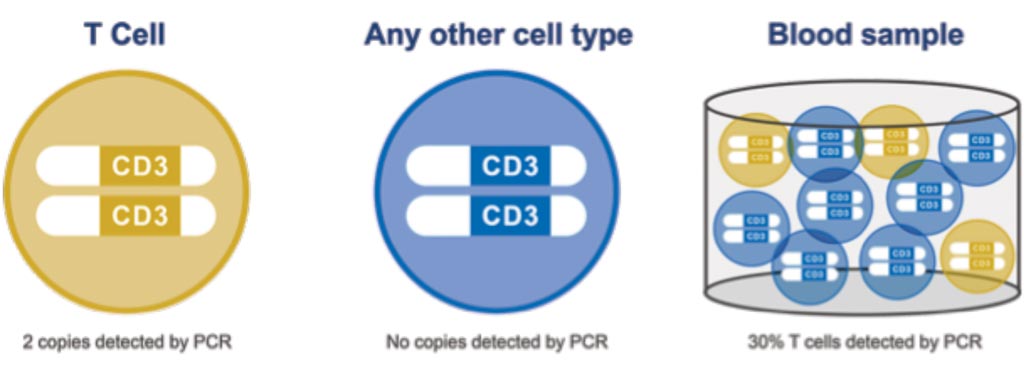Epigenetic Diagnostic Tool Detects Diseases in Newborns
By LabMedica International staff writers
Posted on 14 Aug 2018
Newborns are routinely screened for inheritable diseases by analyzing dried blood spots (DBS) from blood taken from a heel-prick. Among the more than 300 known primary immune deficiencies (PIDs), only Severe Combined Immunodeficiencies (SCID) are detected at birth with the current technology used to analyze the DBS.Posted on 14 Aug 2018
Immune cell profiles provide valuable diagnostic information for hematologic and immunologic diseases. Although it is the most widely applied analytical approach, flow cytometry is limited to liquid blood. Moreover, either analysis must be performed with fresh samples or cell integrity needs to be guaranteed during storage and transport.

Image: The figure illustrates how T cells are detected in a blood sample with Epiontis ID. In T cells, the CD3 gene region is epigenetically active (yellow); in all other cell types, this region is epigenetically inactive (blue). The number of epigenetically active CD3 gene copies directly translates to the number of T cells in the sample (Photo courtesy of Precision for Medicine).
An international team of scientists working with those at the Karolinska Institute (Stockholm, Sweden) developed epigenetic real-time quantitative polymerase chain reaction (qPCR) assays for analysis of human leukocyte subpopulations. After method establishment, whole blood from 25 healthy donors and 97 HIV+ patients as well as dried spots from 250 healthy newborns and 24 newborns with primary immunodeficiencies were analyzed.
The epigenetic qPCR used in the study was provided by Epiontis GmbH (Berlin, Germany). The team evaluated the concordance between flow cytometric and epigenetic data for neutrophils and B, natural killer, CD3+ T, CD8+ T, CD4+ T, and FOXP3+ regulatory T cells, demonstrating substantial equivalence between epigenetic qPCR analysis and flow cytometry. Epigenetic qPCR achieves both relative and absolute quantifications. Applied to dried blood spots, epigenetic immune cell quantification was shown to identify newborns suffering from various primary immunodeficiencies. Using epigenetic qPCR not only provides a precise means for immune cell counting in fresh-frozen blood but also extends applicability to dried blood spots.
The novel alternative approach, using epigenetic quantitative real-time PCR (qPCR) assays was shown in the study to successfully detect a larger number of PIDs including, not only SCID, but others, such as X-linked agammaglobulinemia (XLA), immune dysregulation, polyendocrinopathy, enteropathy, X-linked (IPEX) syndrome; and severe congenital neutropenia (SCN), severe diseases that often clinically manifest within months of birth.
Sven Olek, PhD, managing director of Epiontis GmbH and a study author, said, “This technology is simple and inexpensive to use, making it especially promising for improving the care of HIV patients where monitoring blood cell counts is critical to proper treatment but extremely difficult to do in parts of the developing world where storing and transporting liquid blood is not feasible. Since a drop of the patient's blood can be placed on a piece of paper and mailed into a laboratory for analysis, this technology eliminates a patient's need to travel, often long distances, to a facility to have blood drawn. This increases the probability that the patient's immune cell counts will be more consistently monitored.”
The authors concluded that their method could expand the ability for screening immune defects and facilitate diagnostics of unobservantly collected samples, for example, in underdeveloped areas, where logistics are major barriers to screening. The study was published on August 1, 2018, in the journal Science Translational Medicine.
Related Links:
Karolinska Institute
Epiontis














